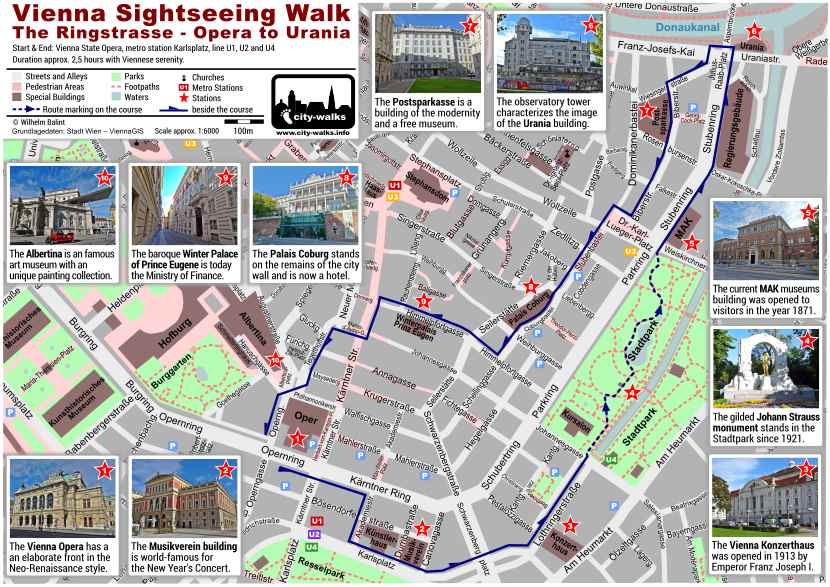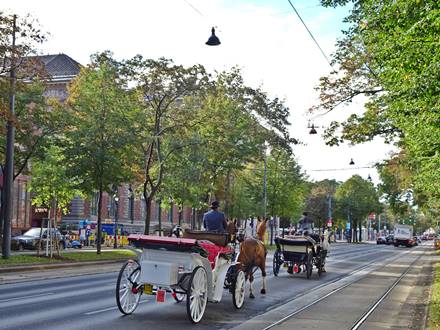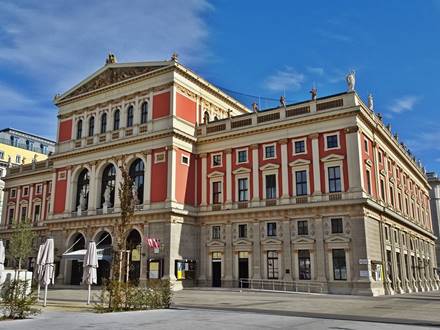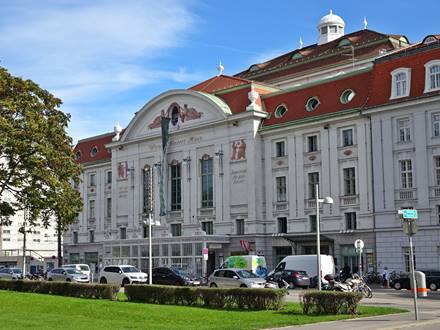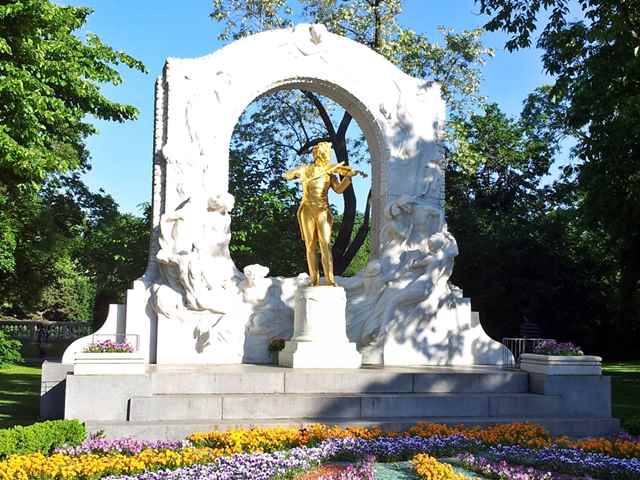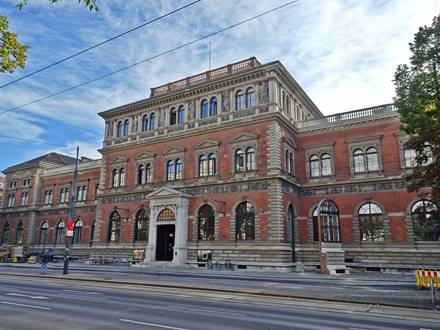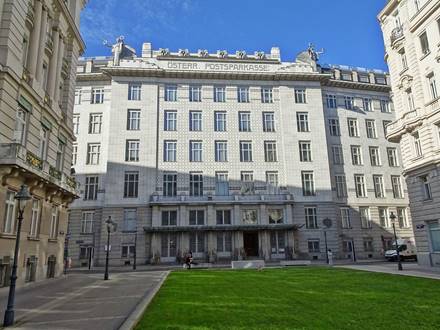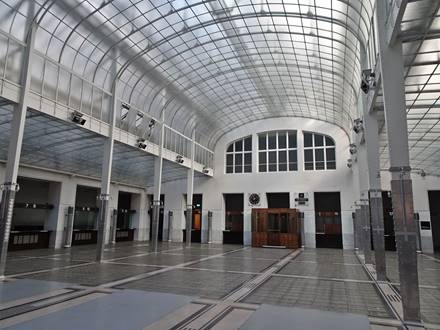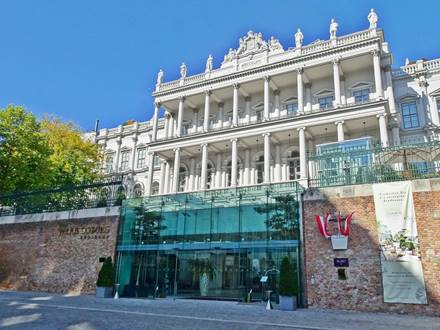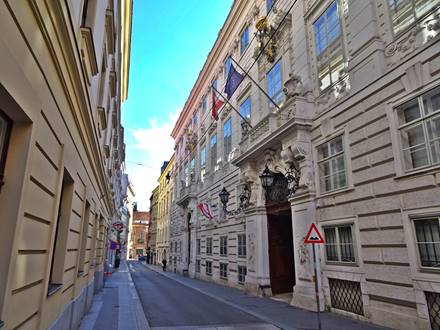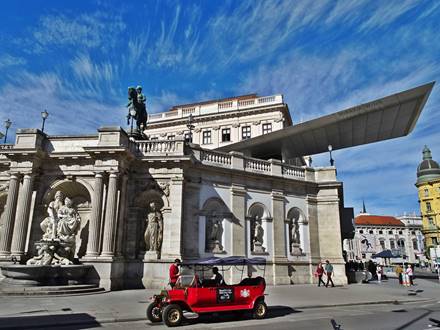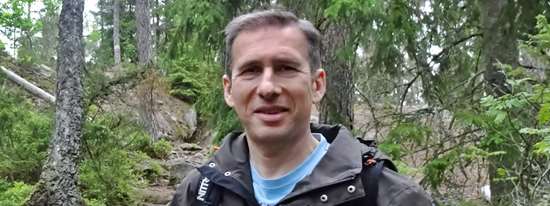Vienna Sightseeing Walk Ringstrasse
Just click on the image below to open the free PDF map!
The map with the sightseeing walk is ideal for printing or to save it directly on your smartphone.
Viennese Ringstrasse - Ring Road
The Viennese Ringstrasse surrounds circular the 1st district in the center of Vienna. The multi-lane street was built as a boulevard instead of the demolished city wall in the middle of the 19th century. The emperor at that time, Franz Joseph I., gave the order for this. As a result, many new magnificent buildings were built around the Ringstrasse.
This sightseeing walk takes you along the eastern part of the Ringstrasse from the Vienna State Opera to the Urania building. The route runs only on some parts directly on the Ringstrasse. Most of the time it runs parallel to the Ringstrasse to show you the most beautiful places in the area.
Due to the length of the Ringstrasse, this walk does not cover the entire Ring Road. If you want to discover the well-known buildings of the western area, then you should have a look on another walk, the Walking Tour City Center. This walk is the right choice if you like to see the Hofburg, the Town Hall or the Parliament on the Ringstrasse.
Stations of the Walk
The construction of Vienna Opera House was completed in the year 1869. Unfortunately, parts of the building were destroyed by a bomb hit during an air strike against Vienna in the World War II. The front facade, however, remained intact. You can still see the original facade in the Renaissance arch style from the 19th century. The house is not only famous for its opera performances, but also for the annual Opera Ball and the orchestra. In order to be accepted by the famous Vienna Philharmonic, one must have played in the orchestra of the State Opera for at least 3 years.
The opening of the Musikverein building was in 1870, one year after the State Opera opening. The concert house is one of the magnificent buildings near the Ringstrasse and is certainly one of the most beautiful concert houses in the world. It was constructed in the Greek Renaissance style. The architect Theophil Hansen was born in Denmark and studied in Greece for several years. The Golden Hall in the building is a unique concert hall and is famous for the New Year's Concert of the Vienna Philharmonic Orchestra, which is watched by over 50 million viewers worldwide.
The Viennese Concert House was ceremoniously opened in the year 1913. As like with many other buildings around the Ringstrasse, Emperor Franz Joseph I. was present at the opening. Just like at that times, the Concert House is still the main venue of the Vienna Symphony Orchestra and a popular house for international orchestras and well-known jazz stars. Among the 4 concert halls, the Great Hall is particularly noteworthy. It provides an impressive scenery for a special musical experience.
The Johann Strauss monument in the Stadtpark was erected in 1921. The Vienna Philharmonic Orchestra played at the unveiling ceremony. The gilded bronze statue is an eye-catcher and certainly the most popular photo motif in the Stadtpark. The park is located between the Ringstrasse and the river Wienfluss. It is a well-attended green oasis in the center of the city. Many Viennese relax here in their leisure time. The numerous benches are perfect for a short break during your walk. Take the opportunity and experience personally the typical Viennese serenity.
The MAK - Museum of Applied Arts was founded in the year 1863. The building on the Ringstrasse was constructed for this museum and opened in 1871. It was the first building for a museum on the new Ringstrasse and it was erected in the Renaissance style. The model for the museum was the predecessor of today's Victoria and Albert Museum in London. Today the museum focuses on design, architecture and contemporary art. The collection on display includes glasses, carpets, furniture and graphics from various periods of art history.
The Urania building was built in Neo-Baroque style and the opening was in the year 1910. The tower with an observatory at the top characterizes the appearance of the building. Originally, the premises were mainly used for scientific lectures to the general public. Today there is an observatory, a cinema, a puppet theater and a restaurant with a roof terrace directly above the Danube Canal.
The building of the Austrian Postal Savings Bank is one of the most important Viennese buildings in Art Nouveau style. It was designed by the well-known architect Otto Wagner and completed in 1912 and at that time it was a very modern construction. Otto Wagner's motto was: What is impractical can never be beautiful! This guiding principle was also applied on the design of the entire interior. You should just see it for yourself! Some rooms in the building belong to the University of Vienna and there is the Café Exchange. The café is usually open Monday to Friday from 9:00 to 17:30 and Saturday from 10:30 to 17:00 o'clock. .
The Palais Coburg was built between 1840 and 1845 and towered originally over the city walls of Vienna. The numerous narrow columns in the front inspired the people in Vienna to call it the Asparagus Castle. Over time, the palace has had numerous functions and is today a noble hotel.
The Winter Palace of Prince Eugene is located in a long and narrow alley with the name Himmelpfortgasse. Prince Eugene was a famous general who led the Habsburg army in numerous battles like in the Great Turkish War. From the end of the 17th century, Prinz Eugen had a representative accommodation in the city with this winter palace. In the summer time he lived usually in the famous Belvedere Palace. Today the Ministry of Finance is located in the Winter Palace of Prinz Eugen.
The Albertina is an important art museum in Austria and houses a world-famous collection of paintings with works by Pablo Picasso, Claude Monet, Marc Chagall ... The building of the Albertina is the Palais Erzherzog Albrecht. The originally name of the palace was Taroucca and it was built from 1742 to 1745. The palace is constructed on the remains of the Augustinerbastei, which was formerly part of the city's fortification complex.
Details about the Walk
Start:
The sightseeing walk starts in front of the Opera House at the Opernring, which is part of Vienna's Ringstrasse. The nearest metro station, Karlsplatz, is about 200 meters away and is quite easy to reach. The metro lines U1, U2 and U4 stop directly there.
Route:
Since there is all the time a lot of traffic on the multi-lane road of the Ringstrasse, the route runs only for short sections directly on it. In most cases, the route goes parallel to the Ringstrasse and leads to the most important buildings and popular places around the eastern section of the Ringstrasse. The walk is perfect for sightseeing and you will see narrow alleys, a green park and many impressive squares along the route.
Duration:
With Viennese serenity, the entire walk takes about 2,5 hours.

